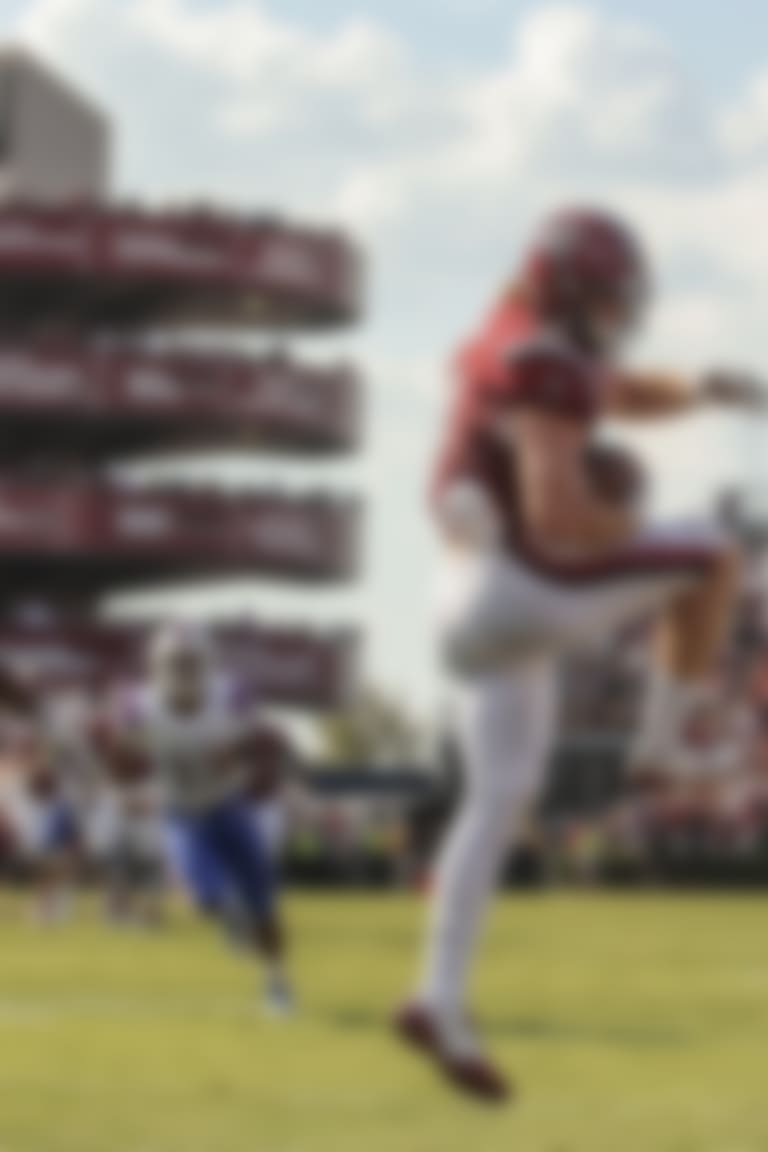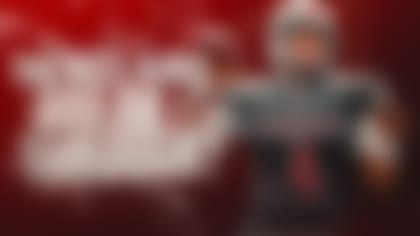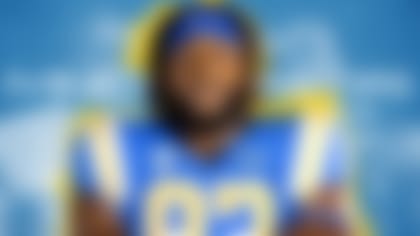Hayden Hurst's major-league pitching career lasted just five batters. A case of the yips forced him out of baseball and opened up a whole new world.
By Chase Goodbread | Published Jan. 10, 2018
JACKSONVILLE, Fla. -- When the shell first began to crack, Hayden Hurst was standing on the mound at the Pittsburgh Pirates' spring training facility in Bradenton, Fla., in May 2013. One of the most promising young pitchers in the Gulf Coast League, Hurst felt a tinge of nausea as he fired warmup pitches before his first professional game, against the Baltimore Orioles' GCL affiliate.
Just jitters, right?
Ball four.
He looked down at the right hand that needed just five years to rocket him into this position -- a prized rookie holding a golden ticket -- and it trembled.
Ball four.
Who wouldn't have jitters in the same situation?
Numbness in his hand ensued. He looked around, unsure of what was happening or why, and realized he couldn't feel the ball.
Ball four.
The yips were sinking their dreaded claws into Hurst's fast-track career -- with a cruel instant suddenness -- and it never let go. He walked off the mound having faced five batters, walking them all and uncorking a pair of wild pitches.
It would be the last pitch of his baseball career. He would never take the mound in a professional game again.
"It happened just like that," said Jerry Hurst, Hayden's father, snapping his fingers to convey how quickly things turned. "He called us up and was in tears. He didn't understand what was happening."
The yips is a rare and mysterious affliction -- a sudden loss of fine motor skills defined by Merriam-Webster as a "state of nervous tension affecting an athlete in the performance of a crucial action" -- for which there is no reliable cure. It has derailed the careers of former major leaguers such as Steve Sax, Chuck Knoblauch and Rick Ankiel.
For two years, Hurst struggled to overcome the yips. He spiraled into depression -- his own diagnosis, not a clinical one -- trying to escape a dark, daily cloud that hovered over an unraveling baseball career.
Through that cloud, however, came a single ray of sunshine.
It went unnoticed by the pitcher in Hurst. But underneath, the tight end in him felt it.
The depths to which Hurst's spirit sank in Bradenton that day can't be understood without a full accounting of the ease with which pitching had always previously come to him.
As a small boy in Jacksonville, he once fired a baseball from third to first base with so much velocity his tee-ball league bumped him into the kid-pitch division out of fear for the safety of other children.
Years later, he was still in a league with older kids.
He pitched, as an eighth-grader, for the varsity high school squad at The Bolles School, a seven-time state championship program and the prep home of eight-time All-Star Chipper Jones. He mowed down the competition until, at the tender age of 13, his pitching arm required Tommy John Surgery. Renowned orthopedic surgeon James Andrews handled the procedure to replace the right elbow ligament.
"They usually take the replacement from the forearm," said Hurst's mother, Cathy. "But Hayden was so big for his age (6-foot-3, 200 pounds), they took it from his hamstring instead."
After the year-long rehab that is standard for TJS, the velocity on Hurst's fastball began to climb into the 90s. He returned to the mound just in time to lead a postseason run to a state title, the first of two in his career.
Football was the last thing on his mind. Baseball was taking him everywhere.
Halfway around the world, off the coast of China in Taichung, Taiwan, he pitched four shutout innings against Hong Kong in the IBAF World Youth Championships. A week shy of his 16th birthday, with Team USA across his chest, he was surrounded by -- and belonged with -- the most talented young players in the world. Francisco Lindor, who went on to stardom as a Gold Glove shortstop with the Cleveland Indians, scooped up ground balls behind him. Albert Almora, now a promising outfielder with the Chicago Cubs, tracked down his fly ball-induced outs.
He pitched at fabled Wrigley Field, with MLB Network airing his 91-mph fastballs live in the 2011 Under Armour All-American Game. Only 36 high school players in America were selected for it.
Hurst played just one season of football at Bolles, his junior year. His baseball travels prevented him from meeting a requirement of 80 percent attendance at summer workouts to be on the team, as established by legendary prep coach Corky Rogers. When a team vote in favor of Hurst's inclusion convinced Rogers to relent on his rule, he joined the team not as a tight end, but as a wide receiver.
"My first game, my first play, actually, coach Rogers grabbed me by the facemask and said, 'Go run down the damn field and catch the football'. That was his signal for a go route," Hurst said with a laugh. "I went 70 yards for a touchdown."
It proved to be a short-lived thrill.
A year later, surrounded by chatter that his right arm was worth too much money to subject it to football, Hurst sat out his senior season.
Indeed, baseball wasn't just his sport of choice; it was his sport of destiny.
It wasn't supposed to be happening, this absurdly confounding inability to do something -- throw a baseball across the plate -- that he'd always been able to do before.
Not to Hurst, anyway.
Not to the son of a former Bolles and Jacksonville University pitcher.
Not to this imposing, 6-foot-5, 225-pound fireballer who had been, to that point, all but unhittable.
Hurst had always been a little wild -- he walked his share of batters at Bolles -- but he had always piled up enough strikeouts that it didn't matter.
This was different; this was alarming.
In a moment's notice, that once-reliable fastball was bouncing a few feet in front of the plate if it wasn't sailing over the catcher's head.
"I hit a kid from the Orioles in a practice game, and he was knocked out unconscious," Hurst said. "That messed me up even more. It hit him in the helmet. It wasn't good. I never rebounded from it."
Months earlier, in fall instructional camp, the Pirates put their GCL players through a Navy SEAL training program, led by former SEALs, to instill toughness and physical fitness. Hurst and his teammates carried telephone poles, dove into tubs of ice-cold water, and were awakened at 5 a.m. for long-distance runs on the beach.
And now, somehow, all that seemed easy compared to throwing a simple strike.
"I thought I'd be pitching in PNC Park in two years," Hurst said. "It didn't work out that way."
With the ink barely dried on a contract that included a $400,000 bonus -- money typically awarded to players drafted in the third round in 2012, not Round 17, where Hurst was taken by the Pirates -- the environment wasn't exactly optimal for Hurst to straighten things out.
Minor league baseball culture, by its very nature, made for a poor surrounding. Particularly at the lower levels, like the GCL, team camaraderie doesn't build itself easily. Players wear the same uniform, but the real goal isn't to raise a team trophy; it's for the individual to climb to the next level in the system, then the next, until reaching the major leagues.
Clubs do what they can to create chemistry -- indeed, part of the purpose for the Pirates' Navy SEAL training was team bonding -- but ultimately, success is measured individually. As such, there was a mercenary feel to the environment that isolated Hurst all the more. Other pitchers never had to worry about being at the bottom of the ladder, because as long as Hurst couldn't throw a strike, he had that spot occupied. He sensed contempt more than compassion.
At times, it got downright toxic, and an audience that felt more like gawkers than teammates never helped.
"I'd feel petrified, like I was on an island," Hurst said. "There are other guys out there watching me like, 'This guy got $400,000? Are you kidding me?' "
Once, Hurst was spiking pitches into the dirt during a bullpen session, and the pitcher beside him -- practice mounds have two pitching rubbers -- walked off the mound and refused to continue.
"I'm not throwing next to Hurst," he told the pitching coach. "That's contagious."
Hours before players were scheduled to begin practice, Hurst would try to beat the yips with one of the few people in camp who had his trust: former major leaguer Scott Elarton, who had just been hired as a pitching coach. They would play catch in the outfield, and the ball sometimes sailed over Elarton's head. Things could get emotional, and not just for Hurst.
"There were times we were both out there crying," said Elarton.
As more and more players began to hit the field to stretch and get loose, Hurst's anxiety only increased.
"It turns into a sideshow," Elarton said. "It turns into, 'How bad is it?' Guys walk by and it's like driving past a car accident. They don't know whether to look, or act like everything's normal. It's a weird dynamic. We tried to get our work done early."
When daily workouts finished, there wasn't much of a chance to get away.
Hurst was housed in a dormitory for players located right beside the practice fields. And he rarely left his room.
He confided in teammate Stetson Allie, who was already two years into the Pirates system. Like Hurst, Allie was a big, right-handed pitcher with a power arm and poor control, but Allie wasn't dealing with the yips.
That was Hurst's struggle alone.
With an 11 p.m. curfew, Allie was either in Hurst's room, or Hurst in his, until 10:59 p.m. most nights.
"The problem with pro baseball is, you can be too coachable. You start listening to too many people about what you're doing wrong, and you become so mechanical you can't even think for yourself," said Allie, who is now with the Dodgers' Triple-A affiliate in Oklahoma City. "I think that's what happened to Hayden. He wanted to please everyone, so you listen to everyone, and eventually you're paralyzed trying to do so many things."
Meanwhile, the Pirates were moving on.
Elarton had been assigned to Hurst as a project, and the two built a strong friendship, but live games were for fine-tuning skills, not total reconstructions. So Hurst's disastrous five-walk outing turned out to be his only pro appearance.
"They threw him on the backburner, and it demoralized him," Allie said. "It ate at him."
Nobody can say Hurst didn't exhaust every potential avenue of help before finally deciding to take the road that led him to football.
He tried everything.
Apart from working with Elarton, the Pirates sent him to a therapist in Sarasota who believed he had attention-deficit disorder and recommended medication.
That wasn't happening.
He worked with another therapist whose discipline was EFT (Emotional Freedom Technique), also known as tapping. It's designed to separate emotional stress from the body. It didn't. Then there was Dr. Richard Crowley, who had previously worked with major leaguers suffering from the yips.
"Once stress sets in, it can have a disconnecting effect, and athletes can question themselves. Is it psychological? Hell no," Crowley said. "It doesn't do well with a psychotherapist at all. That just aggravates and overloads the player. All the work I do takes place not in the left logical brain, but in the right hemisphere of the brain, where all our emotions are, our intuition, our unconscious. It's a very busy place."
Unfortunately for Hurst, that didn't work, either.
Heck, he even tried hypnosis. He recalls about four sessions with a hypnotist in Jacksonville, but doesn't believe he truly reached his subconscious.
"I would sit back and close my eyes and she would count backward and when she said a certain word, I was supposed to be able to just start talking about stuff," Hurst said. "It didn't help, but I was kind of a skeptic going in. That might've been the problem."
On the baseball side, Elarton wasn't the only coach who sought to help him. Longtime North Florida coach Dusty Rhodes, who had helped arrange Hurst's Tommy John procedure with Dr. Andrews, gave it a shot. So did Don Suriano, formerly of Bolles, who had coached Chipper Jones.
"I ran into his dad at a restaurant and said, 'Give me a month with him. Let's see what happens," Suriano said. "Sometimes we could hardly even play catch, the ball just went all over the place. On the mound, every now and then, he'd turn one loose and you'd say, 'Wow, that's pretty. That's 95 and down the gut.' But he couldn't stay there, and I couldn't push the right button."
As a last-ditch effort, a conversion to first base was tried in in 2014. Hurst hit .245 in 60 plate appearances (with 26 strikeouts), but by then, his exit strategy had begun to take shape. He worked out incessantly, often with Allie, and began packing on more muscle. Despite all his struggles, he still had two assets that few if any players in the Pirates camp could match: work ethic and athleticism. Both could serve him well in another sport, and football had begun to call him. First in the form of quiet, internal musings, then with a louder voice that eventually couldn't be ignored.
"The more he would talk about football, the more he would light up," Elarton said. "I told him one day, 'You need to go play football. Quit beating around this bush, because that's where your heart is.' I gave him a hug. I was glad it was over, he was glad it was over. For Hayden, I think moving on was more of a relief than anything else."
Hurst didn't need any motivation to embark upon his switch to football, but Larry Broadway gave him some, anyway.
When Hurst phoned the Pirates' Director of Minor League Operations to tell him he was finished with baseball, Broadway replied that he hoped Hurst could find something in life he could stick with.
Hurst took it as a thinly-veiled shot; a roundabout way of calling him a quitter.
It stuck with him, and has fueled him ever since.
The University of Florida was a natural place to begin the renewal of his football career. There had been season tickets in the family for decades, it was just 90 minutes from home, and the Gators offense was most certainly in need of help. But when a UF staffer told the family that Florida needed to reserve its walk-on openings for offensive linemen, Hurst took to Facebook, and messaged an old friend.
South Carolina QB Perry Orth had known Hurst since they were kids in Jacksonville, and was excited to see a message from Hurst that he was interested in walking on for the Gamecocks.
"I think he mentioned in the message that he'd just run a 4.58 40, and I knew he was huge," Orth said. "As a quarterback, I was all for it."
By that point, Hurst was home in Jacksonville, working out regularly at Bolles, getting bigger and stronger by the week. A University of Cincinnati recruiter offered him a full scholarship based on nothing more than film from his only season of football at Bolles, and an up-close look at his size, strength and athleticism. But he had negotiated some money for college tuition into his contract with the Pirates, so walking on wouldn't be too costly.
South Carolina was about to lose its top player at the tight end position, Jerell Adams, to the NFL draft. And like Florida, the Gamecocks needed all the help they could get on offense. Orth reached out to recruiting coordinator Steve Spurrier Jr., who arranged a preferred walk-on spot that Hurst chose over several others.













